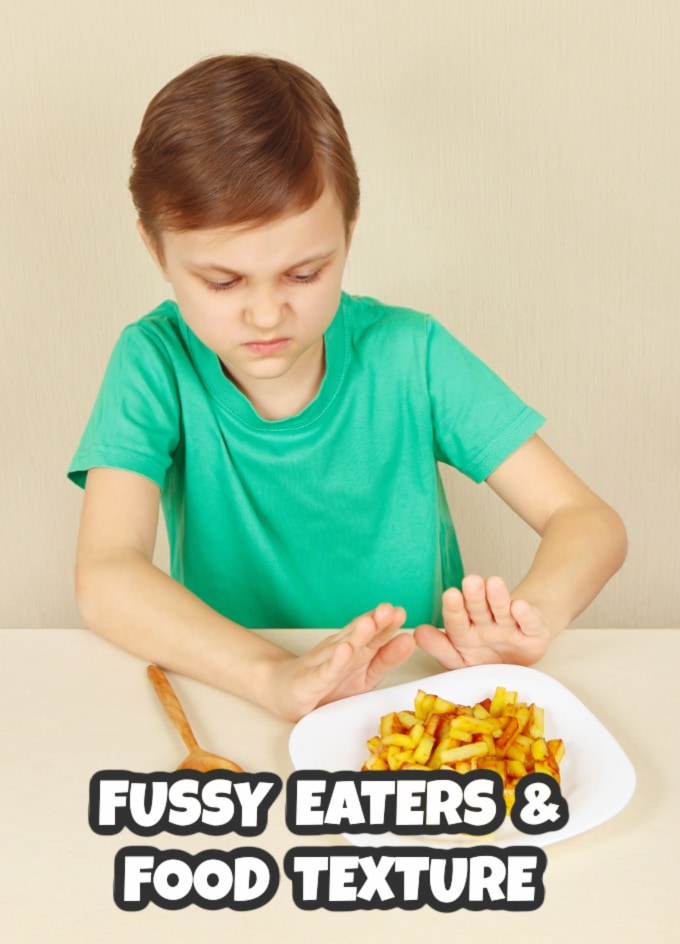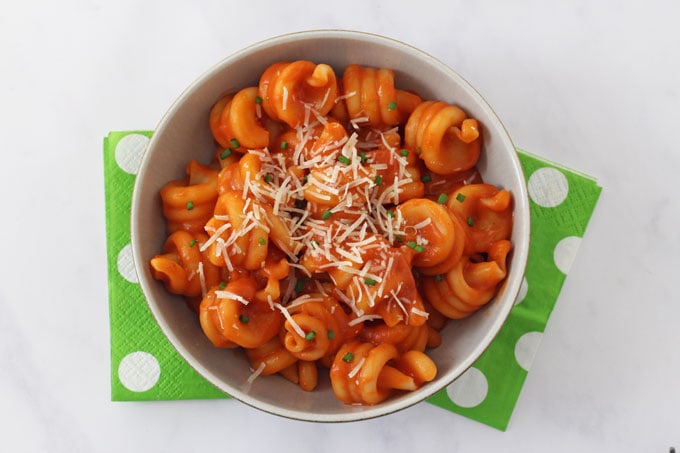
Tips and ideas on how to deal with food texture issues in fussy eaters

One element of fussy eating I get asked a lot about is textures of food and what we as parents can do to help our children learn to love foods of all different textures.
Why Do Kids Have Issues with Texture?
Issues with food textures can occur for a variety of reasons and range from minor picky eating when it comes to certain textures to a severe sensory food aversion. As always with these advice articles, if the issues you are dealing with a more extreme (eg. Sensory Processing Disorder or AFRID) then I would advise that you speak to a professional. The tips here will only be relevant to more moderate cases and it may be the case that more specialised and personalised advice is needed.
The most common textures that children have issue with are wet or sauce-y foods or chewy foods and foods with a lot of natural texture like meat so I will deal with those in the most detail below. However I will also include some more general tips for other types of foods too.
Wet / Sauce Foods
It is quite common for children to have aversions to wet foods or foods with a lot of sauce. Wet food can feel strange in a child’s mouth. It can sometimes be sticky or even slimy. Even sauces or soups that look very smooth can have a textured or grainy consistency to them and meals likes stews and casseroles have so many “bits”.
For a child who feels these textures more acutely than others, sauce-y and wet foods can trigger major sensory aversions.

One little strategy I use to overcome this is to serve the sauce separately. This may seem overly simplistic and it by no means will solve the issues a child may have with texture, but it does serve several purposes.
It gives a picky eating child control over their food. They are able to control if and how much of the sauce they eat and gives them a feeling of input into the meal, rather than it just being forced upon them.
It’s a great way of encouraging your child to try just a bit of the sauce, without fear of it spoiling the whole meal. This can remove a lot of the stress and tension surrounding mealtimes and you can gradually work up the amount of sauce that they eat.
It gives you the opportunity to serve the sauce with other foods. Your child may not like pasta covered in sauce as pasta is already quite a soft food and by adding sauce it’s increasing that mushy texture that they don’t like. Try adding foods with different texture to the plate and you may find that they are more amenable to eating the sauce or as a dip.
In the photo below you can see how I serve Beef Stew to my children. I separate the meat from the potatoes and also add a little bread and encourage them to dip that in the saucey food. A little grated cheese always helps too!

Textured Food / Meat
Another common type of food that children may experience a sensory reaction to is meat or similar foods that are naturally very textured.
Different types of meat can pose different issues on the texture front. Beef in chunks or pieces can be quite chewy and take a lot of work for a child to eat. Minced beef can feel very grainy in their mouth. Poultry like chicken and turkey is often quite dry and again requires a lot of chewing.
There are a few things that you can do to change the texture of meat and make it more appealing to your picky eater.
Try slow cooking chunks of meat like beef and pork. Slow cooked meats are usually much softer and a lot easier for children to eat. They don’t need to chew as much. Cook it until it’s literally falling apart.

For meals that use minced beef such as Spaghetti Bolognese and Chilli Con Carne, try blitzing the meal with a hand blender or in a food processor after cooking. This will help to break down the meat fibres and make the meat less grainy in a child’s mouth. It will also blend the sauce with the meat and any vegetables meaning they are less likely to try to pick bits of the meal out. It will also make it easier to mix these dishes with pasta or rice.
Chicken, and in particular chicken breasts, can be very dry and bland and again requires a lot of work for a child to chew through it. My children definitely have issues eating chicken but I discovered if I blitzed it raw in the food processor and made it into Chicken Meatballs then they were far more likely to eat it as the chicken is a lot softer. This also means you can add other flavours to make it more appealing.
I also recommend to try poaching chicken rather than frying or baking it. It makes the meat much softer and easier to eat.

Other natural foods with a lot of texture that kids may struggle with are beans and pulses. Lentils are so nutritious but extremely “bity” for a child to eat. Again try blitzing them. Try my Lentil Pasta Sauce recipe. Beans become really soft when cooked so try mashing them into the sauce.

Other Foods
There are of course lots of other foods or food groups that children may struggle with from a texture point of view. Some children don’t like any type of breaded or coated foods, dry or crunchy foods, soft vegetables… the list goes on.
My advice in these cases would be to continue to serve up these foods to your child but in small amounts. I am a big fan of the 80/20 rule and divided plates. Fill the plate 80% with food that you know your child likes and will eat. The other 20% can be foods that you want them to learn to enjoy.

We always tell kids not to play with their food but actually playing with foods of different textures can help a child to overcome their initial fear or dislike of it. Allowing them to touch and feel foods without any expectation of eating it will help them to explore different textures in a safe and non-pressured way.
I hope these tips were helpful. If you have any tips of your own then please do let me know in the comments below.






J0-Anne Spencer says
Hello. My 6-year-old son is so fussy with his food, as a baby/toddler he would eat most things I offered to him, but as time has gone on, he now refuses even the simplest of foods. it’s now getting to the point I dread dinner time as I just know there will be food dramas. He seems to have issues with texture and food touching on the plate. Any advice would be grateful accepted.
Vicky says
Hi Jo-Anne, thank you for coming to us to ask for advice, I’ve attached a few links that will hopefully be helpful to you. We also have a website called Pick plates (www.pickplates.com) it’s a range of plates with divided compartments which can sometimes really help to give children choice and control over their food, and very importantly make food fun and more appealing. We really hope this helps, please keep us updated on his progress.
https://www.myfussyeater.com/food-combining-for-fussy-eaters/
https://www.myfussyeater.com/5-tips-picky-fussy-eaters/
https://www.myfussyeater.com/back-school-lunchbox-picky-eaters/
https://www.myfussyeater.com/change-the-way-you-serve-food-to-picky-eaters/
Jane says
Wow I didn’t realise you cover fussy eating & I have followed you for a good while now. My son is now 8 and at 20 months old over night refused meals. I have tried EVERYTHING. The main things he eats are pancakes, no meat other than chicken nuggets, pasta with tomato purée (!!!!!), chips, raw carrot, cheese and a good few fruits. He’s anaemic, & it worries & saddens me every day.. I love my food & eat everything! It’s definitely a texture thing but also a taste thing, he knows if I try and use a “veg based tomato sauce” instead of tomato purée!!!! I dread going out to eat/ family meal times out of the house, friends houses, even camps for Cubs, Xmas etc as it is stopping him going sometimes. Would the book “my fussy eater” be good to buy? I have one of your other cookbooks already but we are no where near there. Any tips would be greatly received. Thanks, jane